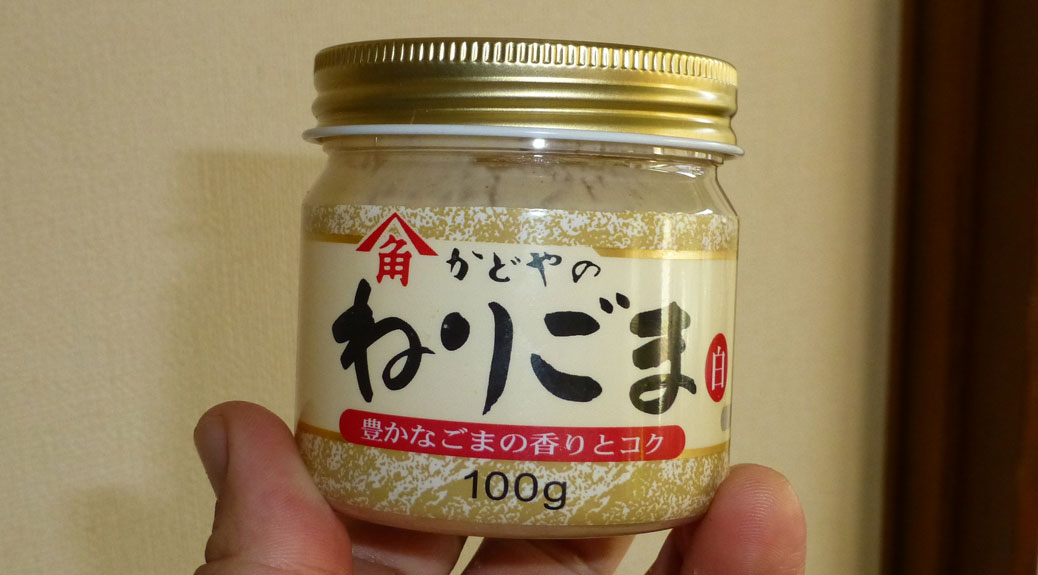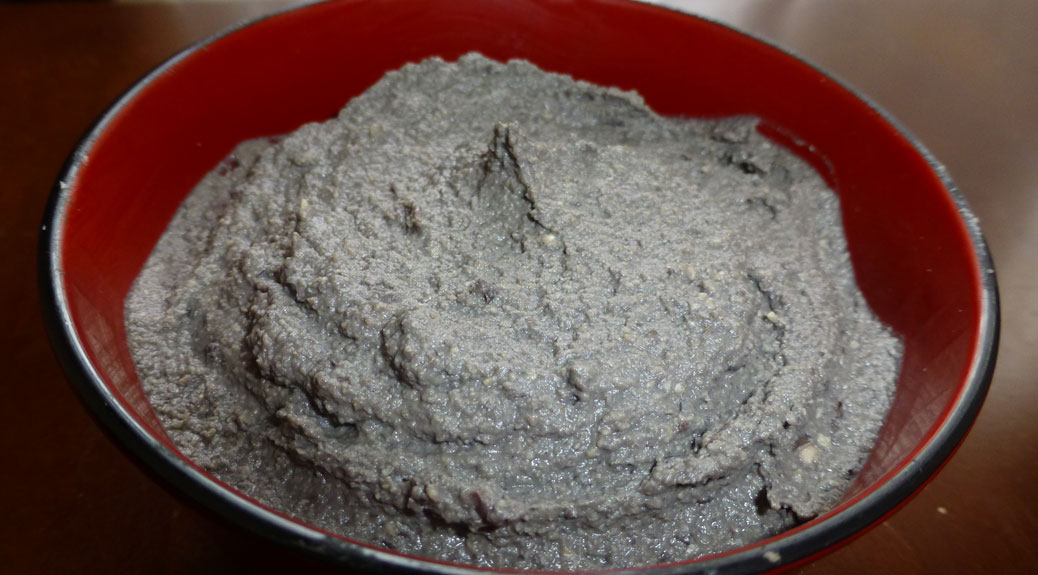I’ve been on a Middle Eastern food kick lately. I found myself longing for one of our favorite restaurants back home and I must’ve had it bad, because it informed half of our meals this week. Happy. Healthy. Life. posted a recipe for Curry Chickpea Cool Cucumber Wraps last week and the tahini cucumber salad reminded me of an impulse purchase I made a few weeks back.
I’d been on a passive search for tahini, but finally decided to look up the Japanese word for it. For those not in the tahini fan club, it’s a paste made from sesame seeds. It’s kinda bitter on its own, but is the primary flavor in hummus and baba ganoush.

Anyway, with Japan’s status as one of the world’s largest importers of sesame seeds, it seemed like tahini should be on the shelves. Turned out it is and with its very own Japanese name: nerigoma (練りごま). There were two options: the standard light-colored paste and (my impulse buy) a jar of black sesame seed paste. I justified this purchase by telling myself that, since dark-colored foods are good for you (it’s a real thing), I’d be doing a disservice NOT buying it.
But what to do with it… ? I usually make hummus with garbanzo beans, but the idea to use the prevalent-in-Japan black soybeans (kuromame) popped into my head. Mix in the black nerigoma and we’re in superfood heaven!
By the time I finally got around to making this, the local gardens were starting to sell the fruits of their labor and one had a bag of Japanese eggplants for 100 yen. Black hummus… baba ganoush… maybe make some falafels… did I put too much thought into a single meal? Perhaps…

Usually bana ganoush and hummus have a lot of olive oil. I chose to omit those from my recipes since they add a LOT of extra calories. Frankly, I didn’t miss them. This was easily the simplest and best batch of baba ganoush I’ve ever made and the hummus is unique in a good way.
Japanese substitutions:
- I used Japanese eggplants, which are skinnier than your standard eggplant. They’re fairly easy to find in the U.S. nowadays and I think they work better for baba than your usual eggplant.
- I used nerigoma, but it’s roughly the same as tahini. The seeds used for nerigoma are toasted, which gives it a slightly different flavor, but tahini will probably be easier to find.
- Baba ganoush usually uses lemon juice, but I used a mix of lime juice and rice vinegar instead. This was just because I had those things in the fridge and hadn’t bought any lemons. I really like what it did to the flavor.
- The black soybeans were really dry, but I didn’t want to add copious amounts of oil and also didn’t want to neutralize the flavor with water, so I added the miso liquid to stay with the Japanese theme. You could use oil or add vegetable broth to get the consistency right.
Tip: If using a blender, I suggest adding the wet ingredients to the jar first. It seems to help the beans work their way down to the blades.
Baba Ganoush
Ingredients
3-4 Japanese eggplants
2 tbsp sesame paste (tahini or nerigoma)
3 garlic gloves
1 tbsp lime juice
1 tbsp rice vinegar
1 tsp cumin
1/2 tsp sea salt
flat-leaf parsley for garnish
Prep
- Puncture the eggplants several times with a fork.
- Put the eggplants under your oven’s broiler until the skin begins to blister and turn black, then flip and repeat on the other side. This takes anywhere from 7-10 minutes. The skin should be charred and the inside of the eggplant should be soft.
- Set aside to cool.
- While the eggplants are cooling, peel the garlic, chop the parsley and set up your blender or food processor.
Cook
- Peel the eggplants. The best way I’ve found is to slice the eggplant down the middle, then take the flat edge of a knife and scrap the flesh off the skin. Make sure the skin is completely removed as the texture can be unpleasant.
- Put the eggplant flesh in the blender. Add the garlic cloves, sesame paste, lime juice, rice vinegar, cumin and salt.
- Blend until smooth.
- Chill for at least an hour before serving. Serve with fresh parsley garnished on top. You may also choose to drizzle olive oil on the top for added richness.
Kuromame Hummus
Ingredients
1/2 cup black soybeans
3 garlic cloves
2 tbsp black sesame paste (tahini or nerigoma)
juice from 1/2 medium lemon (about 2 tbsp)
1 tsp miso paste mixed with 1/3 cup water
1 tsp cumin
1/2 tsp sea salt
Kuromame Hummus Prep
- If you’re using dried soybeans, soak them overnight. Then put in a saucepan, cover with 1-2 inches of water and bring to a boil. Turn down to a simmer and cook until they reach the soft side of tender.
- Set up your blender or food processor.
Kuromame Hummus Cook
- Add the garlic, sesame paste, lemon juice and a couple tablespoons of the miso liquid to the blender.
- Add the soybeans, cumin and salt.
- Blend until smooth. Add miso liquid 1 tablespoon at a time if the mixture is too dry until it reaches the desired consistency.
- Chill for at least an hour before serving. Like the baba ganoush, you may choose to add extra virgin olive oil prior to serving.


What a great post! I just followed you to stay updated on your future posts and I look forward to them. I just started my own vegetarian/political blog, so feel free to check it out and let me know what you think!
http://MannyRutinel.com
Have a great day! 😀
Thanks Manny! Welcome aboard!
Thank you so much! I look forward to future interactions with you. Feel free to follow me on any social media site and I’ll gladly follow you right back! 🙂